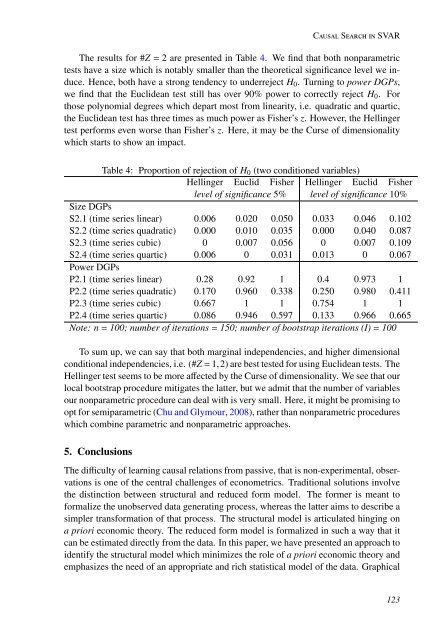Causality in Time Series - ClopiNet
Causality in Time Series - ClopiNet
Causality in Time Series - ClopiNet
Create successful ePaper yourself
Turn your PDF publications into a flip-book with our unique Google optimized e-Paper software.
Causal Search <strong>in</strong> SVARThe results for #Z = 2 are presented <strong>in</strong> Table 4. We f<strong>in</strong>d that both nonparametrictests have a size which is notably smaller than the theoretical significance level we <strong>in</strong>duce.Hence, both have a strong tendency to underreject H 0 . Turn<strong>in</strong>g to power DGPs,we f<strong>in</strong>d that the Euclidean test still has over 90% power to correctly reject H 0 . Forthose polynomial degrees which depart most from l<strong>in</strong>earity, i.e. quadratic and quartic,the Euclidean test has three times as much power as Fisher’s z. However, the Hell<strong>in</strong>gertest performs even worse than Fisher’s z. Here, it may be the Curse of dimensionalitywhich starts to show an impact.Table 4: Proportion of rejection of H 0 (two conditioned variables)Hell<strong>in</strong>ger Euclid Fisher Hell<strong>in</strong>ger Euclid Fisherlevel of significance 5% level of significance 10%Size DGPsS2.1 (time series l<strong>in</strong>ear) 0.006 0.020 0.050 0.033 0.046 0.102S2.2 (time series quadratic) 0.000 0.010 0.035 0.000 0.040 0.087S2.3 (time series cubic) 0 0.007 0.056 0 0.007 0.109S2.4 (time series quartic) 0.006 0 0.031 0.013 0 0.067Power DGPsP2.1 (time series l<strong>in</strong>ear) 0.28 0.92 1 0.4 0.973 1P2.2 (time series quadratic) 0.170 0.960 0.338 0.250 0.980 0.411P2.3 (time series cubic) 0.667 1 1 0.754 1 1P2.4 (time series quartic) 0.086 0.946 0.597 0.133 0.966 0.665Note: n = 100; number of iterations = 150; number of bootstrap iterations (I) = 100To sum up, we can say that both marg<strong>in</strong>al <strong>in</strong>dependencies, and higher dimensionalconditional <strong>in</strong>dependencies, i.e. (#Z = 1,2) are best tested for us<strong>in</strong>g Euclidean tests. TheHell<strong>in</strong>ger test seems to be more affected by the Curse of dimensionality. We see that ourlocal bootstrap procedure mitigates the latter, but we admit that the number of variablesour nonparametric procedure can deal with is very small. Here, it might be promis<strong>in</strong>g toopt for semiparametric (Chu and Glymour, 2008), rather than nonparametric procedureswhich comb<strong>in</strong>e parametric and nonparametric approaches.5. ConclusionsThe difficulty of learn<strong>in</strong>g causal relations from passive, that is non-experimental, observationsis one of the central challenges of econometrics. Traditional solutions <strong>in</strong>volvethe dist<strong>in</strong>ction between structural and reduced form model. The former is meant toformalize the unobserved data generat<strong>in</strong>g process, whereas the latter aims to describe asimpler transformation of that process. The structural model is articulated h<strong>in</strong>g<strong>in</strong>g ona priori economic theory. The reduced form model is formalized <strong>in</strong> such a way that itcan be estimated directly from the data. In this paper, we have presented an approach toidentify the structural model which m<strong>in</strong>imizes the role of a priori economic theory andemphasizes the need of an appropriate and rich statistical model of the data. Graphical123





